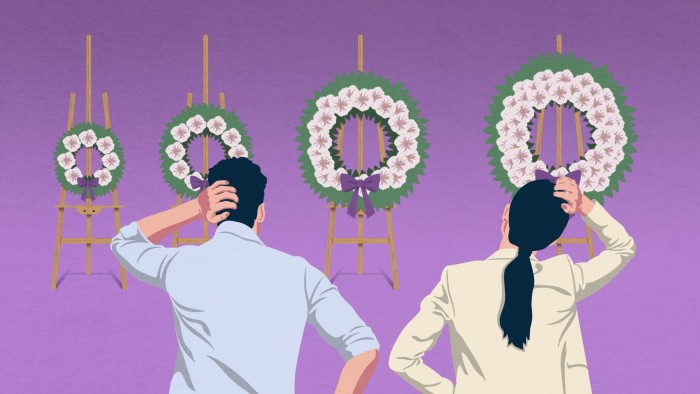Unlock the Editor’s Digest for free
Roula Khalaf, Editor of the FT, selects her favourite stories in this weekly newsletter.
“We can leave the flowers outside for the rabbits, or you can give them to someone who can’t afford flowers for their funeral.” It was at this point in the conversation with the undertaker that it dawned on me. Some people can’t afford flowers at their funeral.
Bouquet chosen, next up: Mum’s coffin. Picking a coffin, it seems, can be like choosing a sofa. As the undertaker turned each page of the corporate brochure they got progressively more elaborate and expensive, with names like “Merrion”, “Dunmore” and “Chatsworth”.
When we’d been through the menu of options and resisted the gentle upselling, the undertaker told my sister and me the total price. It seemed a great technique for drumming up new business — I wonder how many relatives die of shock when they hear the bill?
About £4,300. (Bang on the national average, I later learned.) Forget flowers. Many people just can’t afford to die.
“We can make it cheaper,” said the undertaker comfortingly.
I was intrigued at this point by just how cheap it might be possible to go. It turns out that it was £1,395. The undertakers simply turn up at the crematorium and drop off the coffin. No service. Nothing. It is called a “direct cremation” or “cremation without ceremony” and is becoming increasingly popular.
Roughly 80 per cent of people opt for a cremation in the UK each year. Demand for direct cremations rose during the pandemic — about one in seven cremations were dealt with this way.
Research for the Centre for Death and Society at the University of Bath a couple of years ago found no difference in the “grief experience” between those organising a traditional funeral service and those not.
Over the next two weeks, I planned Mum’s send-off. She was nearly 91 and had been in a care home with dementia for four years. If you want a big funeral you need to die young. By the time you are 90 your friends and relatives are either dead or too old to travel. We were not expecting many mourners, so we decided on a simple ceremony at the crematorium.
She was a Salvation Army officer. We wanted some hymns, a couple of tributes, a reading and prayers. All had to be timed to the second after the undertaker called a few days before, warning me that if we went over our allotted 35 minutes we would be fined.
“The service is at 4.30pm in the afternoon. There’s no one waiting to follow us. How much will be fined?” I asked. “Er . . . We get into trouble — the crematorium staff tell us off,” came the mumbled response.
I spent hours putting together a couple of PowerPoint presentations to run behind the tributes. The crematorium could not let us control the slides ourselves — with the right picture landing just at the right point. It had to be 10 seconds a slide, no more than 25. That will be another £49 for each set, thank you.
Then came the time to upload the music and presentations. The crematorium online platform didn’t accept PowerPoint. At this point I suddenly realised how stupid we had been.
Could we just cancel? That night I rang my family. To my surprise, everyone agreed. Some were relieved. The undertaker was tremendously understanding the next morning — this was less than a week before the ceremony was due. In half an hour everything was cancelled and a refund given. We opted for a direct cremation instead.
Without the presence of a coffin you are free to do what you want, where you want, when you want. At such short notice we simply switched the venue of the ceremony — to a Salvation Army hall.
The service was relaxed. We welcomed people with tea and cake (made with Mum’s famous rock bun recipe). We were more creative. It was more meaningful. At the end, no one got up — they wanted to sit and listen to the music they should have been walking out to.
The reason people pay more than £4,000 and follow a silver Rolls-Royce to the crematorium is because that is how things have been traditionally done.
I, for one, do not need people to see me safely nailed into my coffin to sob over me. I would much rather they held a thanksgiving ceremony (I hope there are some thanks to be felt) without me.
Give my body to science if you will — I am not sure anyone will want it. Do the cheapest thing possible and free yourselves up to arrange the real party without me in a much more informal and appropriate setting.
Mine can be in a rose garden at the height of the blooming season. As my daughter said: “You don’t find your loved ones in a coffin; you find them where they loved to be.”
I think lots of people would prefer this. But here’s the rub. Families need permission. As we were finalising the forms for the direct cremation, the undertaker told me: “It’s amazing how many families can’t afford a funeral but have to do the whole works because other family members insist.”
Release your family from the shackles and costs of tradition and you may find you’re saving them a lot of unnecessary trouble — even grief.
And the money saved? Give that to families who can’t afford even the basics. Or, in my case, use it to pay a gardener to mulch and prune all those roses I’ve left behind.
Martin Stott writes the Storyteller Garden blog




